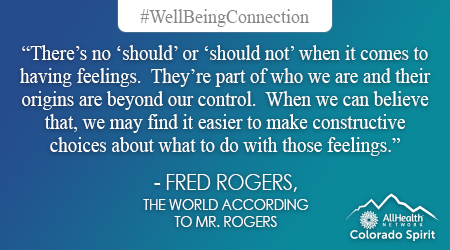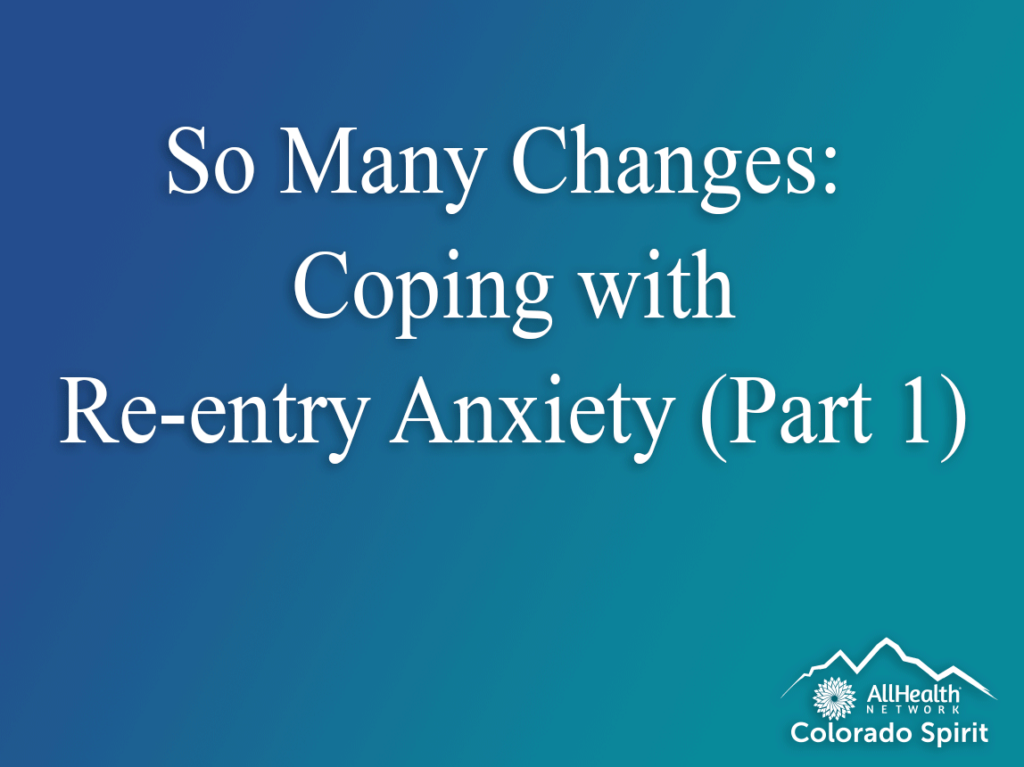For the past few months, the Colorado Spirit Team at AllHealth Network has been talking about all the changes our communities are experiencing and exploring strategies that can help all of us navigate and tolerate transitioning to more in person work and social activities. With the changes in the past week to mask wearing recommendations and businesses changing operating practices, this topic seems even more pressing. I don’t know about you, but changing the way I do things is feeling a bit difficult. I am simultaneously excited and a bit worried about what feels like another big and abrupt change.
The first message our team wants to share is that however you are feeling right now, it is completely understandable and you are not alone in your feelings. After a year plus of adjusting the way we do things, many of us have gotten used to things being a certain way. Some of us will feel very comfortable shifting back to what things “used to be like” and others of us will feel uneasy or worried about shifting back. Some of us might even feel “re-entry fear” or “re-entry anxiety.” We encourage everyone to be patient with themselves and others.
We also like to use Psychological First Aid (PFA) as a frame to help all of us tap into our resiliency during times of transition (For more information on what PFA is check out our blog post from December 2020). All the different models of PFA have 5 things in common: addressing safety, engaging in calming practices, building hope, being able to take action to help ourselves and others, and making social connection.
This week we will dive into some strategies around the safety and calming domains and next week we will explore suggestions for building hope, taking action, and engaging connections.
Strategies for Addressing Safety
Our brains are wired to attend to the safety of our environment, so we encourage you to think about what helps you feel “safe enough.” Some examples of things that can help build feelings of safety are:
- Communicate with others about what helps you feel safe and consider if there are requests you can make for support around this.
- Consider entering into new situations a little at a time instead of jumping in all at once. For some of us, this gradual exposure will help us combat worry thoughts and feelings of anxiety.
- Pay attention to feelings of anxiety instead of just ignoring them. Label the feelings and then look for the underlying communication. Would taking a step back be helpful or would challenging your anxiety with continued action help?
- Remember that a little bit of anxiety and stress is actually helpful as it can motivate us. The trick is to find the sweet spot. Think about feeling worried about a test. Too much anxiety might paralyze us, but a moderate amount actually helps push us to prepare and study. What is the sweet spot for any worry or anxiety about resuming certain activities? Remember, there is benefit to finding ways to build tolerance to this worry as opposed to completely avoiding situations that bring it on.
- Be mindful of media consumption. How does reading different articles or watching different news reports impact you? Identify what information you really need to make decisions and step away from media coverage beyond that.
- Practice reframing your thoughts and try to embrace the uncertainty. Jud Brewer shared in a recent interview with the Wall Street Journal , “Instead of freaking out and thinking: ‘oh no!’ try to think ‘oh, this is different.’ Curiosity feels better than anxiety.”
Calming Practices
Once our brains identify a threat in our environment, our stress response is activated and we have many physical responses. We all benefit from doing things that help our bodies counteract this response and physically calm down. Some possible calming strategies are listed below:
- Make sure you are allowing yourself time and space to rest.If you are having trouble with sleep, consider if there are some adjustments to your sleep routine that might help (check out our past weekly well-being connection about sleep for some tips).
- Engage in practices that help you relax.Relaxation techniques are skills, and just like learning to ride a bike or drive a car, they take practice! Find one or two skills and practice them, regularly, even for just a few minutes a day! Check out our blog post from May 2020 about anxiety for a few skills that might help. You can also watch some of our Tuesday Talks about mindfulness and breathing exercises for some guided practice.
- Balanced eating patterns and being mindful of alcohol consumption or use of other substances are still relevant. While it is tempting to use food or substances to shift our mood, in general this strategy can exacerbate our anxiety and stress in the long run.
- Get moving. We have said this many times before and even devoted a whole post to it last year.It bears repeating though. Sometimes the best way to calm ourselves is to expend pent up energy with movement and exercise.
Look for next week’s post for additional suggestions and please don’t hesitate to reach out! We know these transitions are landing on all of us differently, and the Colorado Spirit team is here to be a free support and resource regardless of your individual situation.

Would speaking to someone help?
To speak with someone in the Colorado Spirit Program about stress related to the pandemic, please call 720-707-6789 or visit our web page at www.allhealthnetwork.org/Colorado-Spirit
For information about other services at AllHealth Network or to get connected with ongoing behavioral health support, please call: 303-730-8858.
AllHealth Network is continuing to provide service via telehealth or by phone and our Crisis Walk-in Center remains open 24/7. To learn more about what other community mental health centers are doing, please visit The Colorado Behavioral Health Council COVID-19 website.
If you are experiencing a mental health crisis and are in need of immediate assistance, please call the Colorado Crisis Hotline at 1-844-493-TALK (8255) or text TALK to 38255.


